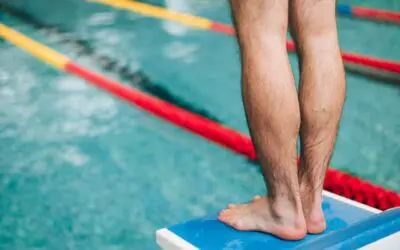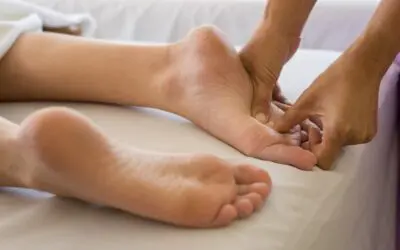If your doctor has told you or a loved one that they have metatarsalgia, you may have a lot of questions, beginning with how to pronounce it (meh-tuh-tar-SAL-jee-uh). We’ve compiled a list of common questions and answers surrounding metatarsalgia to help you learn all about this foot condition.
What is metatarsalgia?
Metatarsalgia is a condition characterized by pain and inflammation in the ball of the foot, specifically around the metatarsal heads (the bones that connect the toes to the midfoot). It typically occurs due to excessive pressure, overuse, or injury to the area.
How does metatarsalgia feel?
Metatarsalgia often feels like a sharp or burning pain in the ball of the foot. Walking, running, or standing for long periods can make your symptoms worse. It may feel like there is a pebble or lump under the foot.
Why do I have metatarsalgia?
Common causes of metatarsalgia include:
- Wearing ill-fitting footwear
- Sporting high heels
- Participating in high-impact sports
- Having foot deformities (such as bunions or hammertoes)
- Having certain foot shapes (like a high arch or a long second toe)
What can I do for my metatarsalgia?
Rest
Rest your foot as much as possible. Ice is also helpful in reducing swelling and alleviating pain.
Switch Up Your Shoes
Wearing supportive, properly fitting shoes with a wide toe box and low heel can relieve pressure on the metatarsal heads.
Custom Orthotics
A podiatrist can fit you for custom orthotics that can redistribute pressure and support the arch of the foot. These inserts will help alleviate the pain.
Medications
If the pain is getting in the way of your favorite activities or daily chores, over-the-counter anti-inflammatory drugs may be helpful to reduce pain and inflammation.
Exercises
A podiatrist can recommend exercises to strengthen the foot muscles and improve flexibility. These exercises may also help prevent recurrence.
Surgical Intervention
In severe cases, your podiatrist may recommend surgery to correct underlying foot deformities or to remove damaged tissue.
How can I prevent metatarsalgia pain?
- Wear shoes that fit properly and provide adequate support, particularly in the area toward the front of the foot.
- Avoid high heels or shoes with narrow toe boxes that can increase pressure on the metatarsal heads.
- When you increase the amount that you exercise, gradually increase the intensity and duration of physical activities to avoid overuse injuries.
- Maintain a healthy weight to reduce pressure on your feet.
- Consider using custom orthotics if you have foot abnormalities or high arches.
Can metatarsalgia really be caused by wearing high heels?
Yes, regularly wearing high heels can contribute to metatarsalgia. High heels force your body weight onto the balls of the feet, increasing pressure on the metatarsal heads. This prolonged pressure can lead to inflammation, pain, and eventually metatarsalgia.
Is metatarsalgia the same as Morton’s neuroma?
No, metatarsalgia and Morton’s neuroma are different conditions. Metatarsalgia refers to pain and inflammation in the ball of the foot, whereas Morton’s neuroma is a specific condition involving a thickening of the tissue around one of the nerves leading to the toes, usually between the third and fourth toes. Both conditions can cause pain in the forefoot, but they have different causes and require different treatments.
Can metatarsalgia cause numbness in my toes?
Yes, metatarsalgia can sometimes cause numbness and tingling in the toes. This sensation often accompanies the pain and may indicate nerve involvement or compression due to inflammation in the ball of the foot.
Should I see a doctor for metatarsalgia?
You should see a podiatrist if you experience persistent or severe pain in the ball of your foot, especially if it interferes with your daily activities or if you notice any changes in the shape or appearance of your foot. A podiatrist can diagnose metatarsalgia, determine its underlying cause, and recommend appropriate treatment options.
Can my metatarsalgia be cured completely?
The outcome of treatment for metatarsalgia depends on the underlying cause and the effectiveness of the chosen treatments. In many cases, proper footwear, orthotic devices, and lifestyle modifications can alleviate symptoms and prevent recurrence.
However, if the condition is caused by structural issues in the foot or if it has progressed significantly, complete resolution of symptoms may require ongoing management and possibly surgical intervention in severe cases.
Can exercises help with my metatarsalgia?
Yes, exercises that strengthen the muscles of the foot and improve flexibility can be beneficial for managing metatarsalgia. Stretching exercises for the calf muscles and plantar fascia can help reduce strain on the metatarsal heads. Additionally, exercises that focus on strengthening the intrinsic muscles of the foot can provide better support and stability, reducing the impact on the forefoot during activities.
What shoes should I wear if I have metatarsalgia?
The best shoes for metatarsalgia are those that provide adequate cushioning and support, particularly in the forefoot area. Look for shoes with a wide toe box that allows your toes to move freely without being cramped. Shoes with good arch support and shock absorption can also help reduce pressure on the metatarsal heads.
It’s important to try on shoes and ensure they fit well and feel comfortable before purchasing, especially if you have sensitive feet due to metatarsalgia.
If you have more questions about metatarsalgia or suspect that you may have it, pull out your phone and search “podiatrist near me” to help you get back on your feet quickly.



